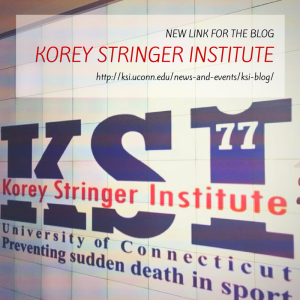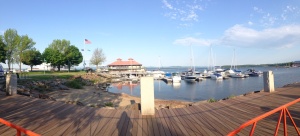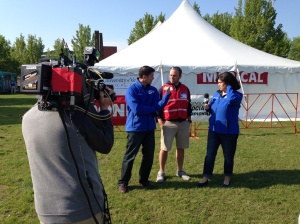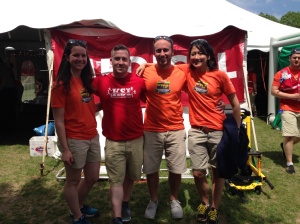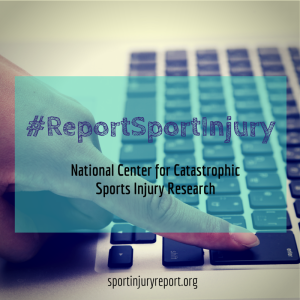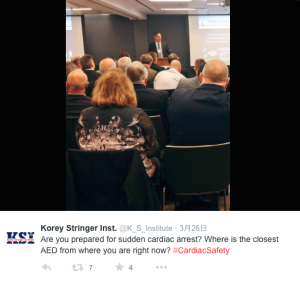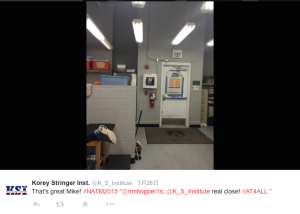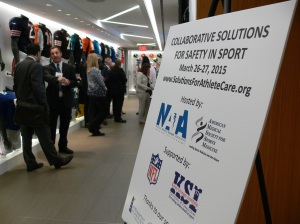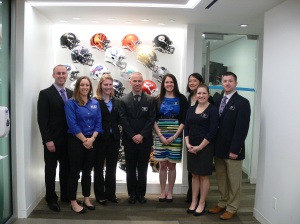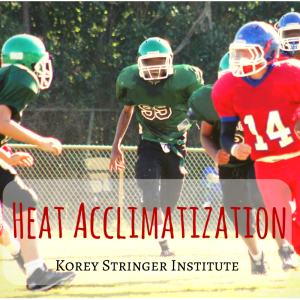Thank you for following the Korey Stringer Insitute WordPress blog. We have transitioned our blog to our website. For future KSI blog updates, please go to: http://ksi.uconn.edu/news-and-events/ksi-blog/
KSI in Vermont City Marathon & Relay
Korea Stringer Institute was represented for the first time at the 27th annual People’s United Bank Vermont City Marathon & Relay that was held on May 24th, 2015 in Burlington, VT. The race included 8,000 participants and began promptly at 8:00am with the Wheelchair participants, followed by the runners at 8:03am.
Members of the KSI, William Adams, Yuri Hosokawa, Luke Belval, and Andrea Fortunati worked in the main medical tent located at the finish line as well as at medical tents located at the midpoint of the race.
This year, there were approximately 150 medical visits seen throughout the day with a total of six athletes transported to the University of Vermont Medical Center.
Four cases of exertional heat stroke were seen and treated at the marathon. During all of these cases at least one member of KSI was present and aided in the treatment process. One case was treated at the medical tent located at mile 13 and the other three cases were treated in the main medical tent at the finish line. In the critical care tent there were two cold-water immersion tubs and members of KSI ready to implement proper protocols and procedures that have been profoundly researched to treat EHS. Treatment for the cases in the critical care tent where done with cold water immersion, which is found to be the quickest and most effective way to cool the body, and rectal thermometers were used for the body temperatures assessment, which is critical in assessing the body temperature in people who are suffering from exertional heat stroke. Once the athletes had been properly cooled, all EHS cases were transported to the UVMMC following the medical organizer’s protocol for a follow-up examination.
This is the second of several marathons KSI will be involved with this year, the first being at the Boston Marathon. Other road races KSI are attending include the Lake Placid Ironman, the Falmouth Road Race, New Haven Road Race, the Marine Corps Marathon, and more.
This is the second of several marathons KSI will be involved with this year, the first being at the Boston Marathon. Other road races KSI are attending include the Lake Placid Ironman, the Falmouth Road Race, New Haven Road Race, the Marine Corps Marathon, and more.
Medical and Science Advisory Board Meeting
On the heels of our uber-successful board meeting and fundraiser gala in early May, KSI held our annual Medical and Science Advisory Board meeting on May 26th, in conjunction with the 62nd annual American College of Sports Medicine Symposium in sunny San Diego, CA. KSI staff members and the MSAB members had the opportunity to discuss progress with on-going initiatives like the Mission Heat Safety Pledge, and discuss future initiatives and directions over a nice dinner. This meeting was an important opportunity for our MSAB to meet and talk about potential collaborations with our new Chief Medical Advisor, Dr. John Jardine.
We also updated the MSAB on our on-going and upcoming research projects. KSI will be going to the Falmouth Road Race to provide medical coverage and perform research on thermoregulation and heat illness with the race participants. Additionally over the next 6 months KSI will be doing research in a field that continues to gain importance in athletics, wearable technology. We also discussed our upcoming travel plans and public appearances. Don’t miss a chance to meet the staff and board members, and pickup information, at the National Athletic Trainers’ Association 66th Clinical Symposium in St. Louis, MO at the end of June.
Several corporate and supply partners were also in attendance, showing continued support of our research and education initiatives. Additionally, one of our educational partners, Jones & Bartlett Learning attended to give an update on our progress with the online continuing education course on preventing sudden death in sport. The course should be available this summer, and is a great resource for athletic trainers in need of evidence-based practice (EBP) CEUs due in December.
Database for Catastrophic, Fatal, and Near-fatal Athletic Injuries
In the midst of a summer that revealed a consistent rate of sudden deaths in athletes, a new mandate affecting all college athletes from the NCAA was announced. The NCAA revealed that as of August 2014 all member schools are required to report any catastrophic injuries incurred by their student-athletes.
This is in support of a new comprehensive and accurate reporting structure to capture such instances. The need for accurate injury incidence information has come from the crucial role this information plays to guide policies for health and safety in sport.
Previously the NCAA has depended on outside researchers such as the University of North Carolina’s National Center for Catastrophic Sports Injury Research database (NCCSIR). The NCAA and the NCCSIR has partnered to enhance this reporting system. The NCCSIR now includes three divisions:
- The University of North Carolina, which oversees traumatic injuries including head, neck and spine injuries
- The University of Connecticut, which oversees exertional injuries including heat-related injuries, asthma and sickle cell trait
- The University of Washington, which oversees cardiac injuries
NCCSIR has provided an online reporting system to expedite and streamline reporting. This system also includes reporting that is available for all organized sport levels (not just collegiate sports). This can be found at: sportinjuryreport.org. We highly encourage any bystanders or witnesses to report cases of fatal or near-fatal incidences (that have occurred in the last year or that occur in the future) to enhance this database.
The hope with all of these new reporting systems is that such information can help to support health and safety initiatives targeting the causes of sudden death in sport and shed light on new preventative measures that can be taken.
As the NCAA chief medical officer Dr. Brian Hainline recently said in an interview regarding a push to mandate screening athletes at higher risk of cardiac death, “Concussions have overshadowed everything. Why aren’t we talking about death?”
We ask that you join the NCAA and the NCCSIR, and help spread the word to report catastrophic injury cases in order to help us push for continued health and safety initiatives that will ultimately save our athlete’s lives.
Pledge your support on social media by using the hashtag #ReportSportInjury
Bishop Lynch High School Automated External Defibrillators
Written by Mike Hopper, ATC, Head Athletic Trainer at Bishop Lynch High School, Dallas, TX
Bishop Lynch High School is a co-educational Catholic high school that is a member of the Diocese of Dallas and a member of the Texas Association of Parochial and Private Schools (TAPPS). Bishop Lynch is a “Safe Sports School” as recognized by the National Athletic Trainers’ Association. The availability of AEDs on our campus is just one example of Bishop Lynch providing excellence in Athletic Healthcare.
Recently, the question was asked on Twitter by the Korey Stringer Institute “Are you prepared for sudden cardiac arrest? Where is the closest AED from where you are right now?” I took a quick picture on my phone of the unit that is permanently posted on the wall just inside of my Athletic Training Room. That is only one unit that currently sits within those 4 walls. Regularly, there are 3 units that are maintained within that facility, however currently we have 5 units there. Two of these units will be deployed elsewhere on campus in the coming months. KSI was understandably amazed and curious how we had 5 AEDs on our campus. But, we actually have 11 of these units posted throughout our 22-acre campus. So, then the question was: How did Bishop Lynch manage to have that many units on our campus and how can other schools learn from us?
I don’t know the full story, but I will say that we are dedicated to having these units within reach and we are dedicated to having a plan to attack sudden cardiac arrest with immediate response and treatment. When I came to BL in August 2014, we had 7 units on campus. Six of these were posted within athletic facilities. The seventh unit has been moved more than once this school year. BL is in midst of major renovations and that unit has floated multiple times before finding its current place. That location has become its new permanent home as this winter we acquired additional units for elsewhere in the building.
There are currently 9 AEDs deployed on our campus. We have units in our end-zone weight room building that serves the weight room and wrestling room in that building plus the baseball field a short distance away. Conceivably this unit also covers the track and football stadium. The fieldhouse in the corner of the same endzone hosts a unit on the wall providing coverage for the football stadium and track. Outside of the “competition gym” a unit is posted in plain sight that provides coverage for the main gym, the dance studio across the hall, and the weight room upstairs in that same building. Upstairs and a short distance away we have a brand new unit that was recently installed near the business office and two classrooms. Our “Legacy Gym” sits just feet away from the new “competition gym” and hosts a unit of its own posted on the wall outside our satellite Athletic Training Room. As we begin to enter the academic end of campus, we have a unit (previously mentioned) that sits outside of the theater. This is also located close to the main office and the cafeteria. Another brand new unit was deployed recently and is now posted on the wall right outside of the nurse’s office. This gives us 7 units posted in permanent locations.
Two more units are located inside of the Fieldhouse Athletic Training Room and these units are portable. This allows the Athletic Training Staff to transport the AEDs to the sideline or dugout of games. Our softball team currently plays off-campus and we are able to take a unit to their games without jeopardizing the safety (and liability) of our campus. We also take an AED with us whenever we travel with our football teams. With approximately 150 people that make up our travel party for a varsity football game, we believe that carrying this unit is necessary at all times.
I currently have two more units sitting in my office that are brand new and still inside of their boxes along with their cabinets. These units are awaiting the completion of new construction. One unit will be installed in the coming weeks as we prepare to open up a new building with 12 classrooms and the last unit will be installed before the 2015-2016 school year when that phase of renovations is completed.
I know that in our athletic facilities we are less than a minute from an AED at all times. There is not a single place that somebody can’t have an AED in hand instantly. The furthest point from an athletic standpoint from an AED is centerfield on the baseball field to the Haggar Building AED in the endzone. That is approximately 500 feet away. But on a game-day, there is a unit in the home dugout cutting that distance down by about 100-150 feet. Academically, we are currently a little bit further away than that in a couple of locations, however that will change in a couple of weeks. Our new unit will cut down that distance significantly. My biggest concern is in our parking lots, which are at the far ends of our campus. Just the other day I brought up this concern to our security staff and we will be addressing this.
Great, so you have 11 AEDs on campus? But do you have staff to use them?
This is a great question. While the AEDs are simple enough to be used by just about anybody, it is still critical that trained personnel respond to a sudden cardiac event. Accordingly, and as required by TAPPS, our entire coaching staff is required to maintain current CPR/AED certification. Additionally, we have a school nurse on campus each day along with one full-time Certified Athletic Trainer and one part-time Certified Athletic Trainer. Our security staff also is required to maintain CPR/AED certification. So in short, we have staff onsite at all times trained to respond to a cardiac event.
How do you maintain 11 AEDs? Who is in charge of that and who pays for that?
This is another great question. And one that we recently figured out. We have three units that are 4 years old, four units that are 3 years old and four units that are brand new. In the past, the replacement pads were simply purchased out of an account and nobody really thought about it too much. But as you can imagine, with 11 units, this is a costly venture. And so the school nurse and I have asked for a specific answer moving forward. We did not want this to be a year-by-year decision. Basically, each year we will spend the equivalent to what it would cost to purchase a new unit every year. But it’s a small price to pay and our school administration agrees with this. For this reason, the nurse’s budget will grow each year to accommodate this specific expense. We share joint responsibility for proposing those needs each year and I have taken on the responsibility of maintaining the units. This includes walking past them throughout the week along with testing them once a month. I have made up a spreadsheet with our entire inventory that includes expiration dates and also have a checklist in each case that I check off each month.
11 AEDs, a full staff of trained personnel, emergency action plans for athletics and campus-wide, combined with EMS being located only minutes away and the major trauma center less than 15 minutes away, we believe that Bishop Lynch is well-prepared for a sudden cardiac event on our campus. While we hope to “waste” a lot of money over time, we believe it’s a small price to pay should somebody on our campus collapse.
Every Athlete Deserves an Athletic Trainer. Every Friar Athlete Has One.
Inaugural Collaborative Solutions for Safety in Sport Meeting
On March 26th and 27th, the National Athletic Trainers’ Association (NATA) and American Medical Society for Sports Medicine (AMSSM) in conjunction with the Korey Stringer Institute (KSI) and the National Football League (NFL) hosted the very first “Collaborative Solutions for Safety in Sport” meeting at the NFL Headquarters in New York, NY. This meeting was made possible by the lead sponsors, NATA and AMSSM. Corporate sponsorship was provided by MISSION Athletecare, Jones & Bartlett Learning, PRIVIT, and Camelback, and supported by KSI and NFL organizations.
We know from years of research that many of the deaths that occur in sport are preventable if best practices for prevention and management are in place. Therefore, the goal of this meeting was to bring together the state high school association leaders and sports medicine advisory committee members and the National Federation of State High School Associations to discuss development and implementation of best practice policies for safety in sport. We are excited to have had representation from all 50 states in one room for this meeting, and provided opportunities for key decision-makers to review and enhance safety policies currently in place in their respective states to reduce risk of sudden death in high school sports.
Chris Valletta, co-founder of MISSION Athletecare kicked off the meeting with the keynote. The remainder of this first day involved emphasis on best practices and policy implementation for heat-related illness and cardiac events. Dr. Douglas Casa, Chief Operating Officer of KSI, spoke about the importance of policies including heat acclimatization and wet-bulb globe temperature monitoring that should be in place at every high school, as well as proper recognition (via a rectal thermometer) and treatment (ice water immersion bath) of heat-related illnesses. Regarding cardiac events, Dr. Jonathan Drezner, team physician for the University of Washington and Seattle Seahawks, spoke about the absolute necessity of having AED’s readily available at all high schools and competition/practice locations, as well as the importance of regularly practicing emergency action plans and performing monthly checks of AED batteries and pads to ensure they are ready to use in case of an emergency cardiac situation.
The second day began with a keynote address from Dr. Brian Hainline, Chief Medical Officer of the NCAA. Following his speech, Ron Courson, Athletic Director of Sports Medicine at the University of Georgia spoke about emergency action plans and when properly implemented, practiced, and executed, can ultimately save the life of an athlete. To close out the meeting, Dr. Kevin Guskiewicz, Director of the Matthew Gfeller Sport-Related Traumatic Brain Injury Research Center in UNC Chapel Hill, spoke about head injuries, including concussions, and the policies that should be in place at every school to protect the health and safety of the student-athletes. Guskiewicz brought home the idea that “This is not an injury that can be managed by a clock, calendar, or cookbook.” Head injuries should be treated on an individual basis, and policies need to be implemented to ensure the athlete is not returning to sport before he/she is physically and cognitively ready.
The meeting was an absolute success for being the first time in history that the key people from each state were together in one room for the same initiative. Great questions, comments, success stories, as well as struggles were brought up from those in attendance. We each face challenges regarding policy development and implementation, but this could be achieved more quickly if we collaborate and work together. With this meeting, the NATA, AMSSM, KSI, and NFL hope to have instilled in the attendees the knowledge and materials the attendees need to return to their respective states and make change happen; change that will follow best practices, change that will ensure athletes are getting the absolute best medical care they deserve, and change that can save a life. “A 2 millimeter difference can make a mile change.” Are you prepared? Do more than care. Think. Act. Make a change. Save a life.
For more resources and information that were shared at the meeting, please visit: www.SolutionsForAthleteCare.org.
MEDIA ALERT: COLLABORATIVE SOLUTIONS FOR SAFETY IN SPORT
MEDIA ALERT:
COLLABORATIVE SOLUTIONS FOR SAFETY IN SPORT:
A Call to Action to Ensure Best Practices and Protocols in High Schools Are in Place
Thursday, March 26, 2015
9:30 a.m. eastern time
NFL Headquarters, 345 Park Avenue, New York City
In 2014, more than 15 high school athletes lost their lives during sports or physical activity. Thousands of student athletes develop acute and long-term injuries as a result of participation. Research shows that many of these deaths and conditions could be avoided if best practices were in place.
Please join the National Athletic Trainers’ Association (NATA) and American Medical Society for Sports Medicine (AMSSM) for a national press conference where sports medicine leaders will discuss and unveil efforts to promote current health and safety protocols. The goal is to develop a collaborative forum to share resources, tools, best practices and strategies designed to advance the safety of student athletes in secondary schools with a focus on emergency action plans (EAPs).
Speakers will address heat-related illnesses, cardiac conditions, head and neck injuries and the need for EAPS in all high schools. While there have been advances in protocol (all states now have concussion laws in place), only 22 percent of states have met the recommendations that every school or organization sponsoring athletics develop an EAP for managing serious and or potentially life-threatening injuries. An editorial on emergency practice guidelines in high school sports will be published that morning in the April Journal of Athletic Training, NATA’s scientific publication.
For the first time ever, and following the press conference, NATA and AMSSM with the support of the Korey Stringer Institute and the NFL, will bring together key stakeholders in high school athletics to discuss these initiatives and improve safety in youth sports. Leaders from all 50 states will be in attendance at the meeting.
Key statistics:
- Emergency Action Plans: 12 percent of states meet the recommendations that every school has a written Emergency Action Plan that is distributed to all staff members; 10 percent of states fulfill the recommendation that the EAP is specific to each venue and includes maps and/or specific directions to that venue.
- Heat Acclimatization Guidelines: 14 of the 50 states currently meet the minimum best practices with regard to heat acclimatization. An estimated 28 percent of states meet the recommendation that total practice time should not exceed three hours in any one day.
- Automated External Defibrillators: Only 50 percent of states have met the recommendations that all athletic trainers, coaches, administrators, school nurses and physical education teachers have access to an AED on school property and at all school sanctioned athletic events/activities.
Speakers:
Douglas Casa, PhD, ATC, FNATA, chief operating officer, Korey Stringer Institute, University of Connecticut: Exertional Heat Stroke
Jason Cates, ATC, LAT, member, Arkansas Activities Association Sports Medicine Advisory Committee; head athletic trainer, Cabot Public Schools; past president, Arkansas Athletic Trainers’ Association: Advancements in Arkansas Youth Sport Safety State Policies and Guidelines
Jonathan Drezner, MD, professor of family medicine; director of the Center for Sports Cardiology; team physician, University of Washington and Seattle Seahawks: Cardiac Conditions
Kevin Guskiewicz, PhD, ATC, FNATA, Kenan Distinguished Professor and director of the Matthew Gfeller Sport-Related Traumatic Brain Injury Research Center, University of North Carolina, Chapel Hill: Head and Neck Injuries
Roman Oben, director, youth and high school football, National Football League; former NFL player: Playing it Safe with Best Practices in Place
CONTACT: Media interested in attending should contact Robin Waxenberg by March 24, 212/489-8006, robin@robwax.com
About NATA: National Athletic Trainers’ Association (NATA) – Health Care for Life & Sport
Athletic trainers are health care professionals who specialize in the prevention, diagnosis, treatment and rehabilitation of injuries and sport-related illnesses. They prevent and treat chronic musculoskeletal injuries from sports, physical and occupational activity, and provide care for acute injuries. Athletic trainers offer a continuum of care that is unparalleled in health care. The National Athletic Trainers’ Association represents and supports 39,000 members of the athletic training profession. Visit www.nata.org
About AMSSM: American Medical Society for Sports Medicine (AMSSM) is a multi-disciplinary organization of 2,700 sports medicine physicians dedicated to education, research, advocacy and the care of athletes of all ages. The majority of AMSSM members are primary care physicians with fellowship training and added qualification in sports medicine who then combine their practice of sports medicine with their primary specialty. AMSSM includes members who specialize solely in non-surgical sports medicine and serve as team physicians at the youth level, NCAA, NFL, MLB, NBA, WNBA, MLS and NHL, as well as with Olympic teams. By nature of their training and experience, sports medicine physicians are ideally suited to provide comprehensive medical care for athletes, sports teams or active individuals who are simply looking to maintain a healthy lifestyle. Visit www.amssm.org
Heat Safety Pledge
Update: The Mission-KSI Heat Safety Pledge for high schools is well underway! We’ve had over 15 schools qualify, with several more applications in the works. Get your school on the list to get some great cooling products from Mission Athletecare!
Congratulations to Marshwood High School in Maine, which was the first school accepted. We have also accepted schools from Alabama, Arkansas, District of Columbia, Florida, Maine, Maryland, Massachusetts, New Jersey, North Carolina, Ohio, Tennessee, and Texas.
A little background on the Heat Safety Pledge: Mission Athletecare prides itself on creating the best athletic environment for performance and safety. As part of that goal, they wanted to find a way to reward schools for upholding appropriate policies for heat safety. Mission wants to donate $1 Million of product to schools nationwide who are striving to keep athletes safe.
And this is where KSI comes in. Mission masterminds, with the help of KSI of course, devised the Heat Safety Pledge, 6 pillars aimed at safety while exercising in the heat. We feel that these are the 6 key areas that help high schools athletes perform at their best and stay safer while exercising in the heat.
- Pillar 1: Thermometer– A wet bulb globe thermometer is on site at school and used to determine activity modifications based on environmental conditions. It is school policy to modify work to rest cycles based on environmental conditions.
- Pillar 2: Certification– All coaching staff is certified in first aid, cardiopulmonary resuscitation and the use of an automated external defibrillator. Additionally, education is provided related to preventing sudden death in sport.
- Pillar 3: Athletic Trainer– An athletic trainer is employed at your school and is on-site during practices and events.
- Pillar 4: Emergency Action Plan– A specific emergency action plan for each athletic facility has been developed where sports games and practices occur. This plan is reviewed with the healthcare team every year.
- Pillar 5: Heat Acclimatization Guidelines– School has adopted nationwide high school preseason heat acclimatization guidelines set forth by the National Athletic Trainers’ Association.
- Pillar 6: Water Stations/Body Cooling- Adequate water is available and placed at various stations around the athletic fields for all sports. At water stations, body cooling is standard practice. This can be as simple as encouraging players to remove equipment during rest breaks as using ice/cold towels.
Some of the pillars of the heat safety pledge require little funding, emergency action plans for example; and can be implemented right away! Appropriate heat acclimatization is regulated by some state athletic associations, so if your state meets the KSI heat acclimatization standards, you already satisfy one of the pillars. But even in states without good guidelines, appropriate heat acclimatization procedures cost no money and can prevent heat illness.
On the same note, we’re talking to YOU high school athletic trainers, your employment helps satisfy one pillar as well. What a way to get some much needed supplies for your school! Take a look at the Heat Safety Pledge today to see if your high school qualifies. If you’re unsure, use the KSI Prevention section for more information on common practice standards. Contact Mission for more information on how to apply.
Heat Acclimatization Research
Strenuous physical activity in hot, humid environments places individuals at great risk for heat-related illnesses and exertional heat stroke. Annually, many individuals, such as athletes, occupational workers, and soldiers suffer from these conditions. Heat acclimatization is, perhaps, the most effective way to mitigate these exertional heat illnesses, as well as improve performance in the heat.
What is heat acclimatization?
The improved ability to exercise in a hot environment due to physiological adaptations that occur over a period (10-14 days) of repeated exposures to exercise-heat stress.
Physiological adaptations of heat acclimatization:
- Improved cardiovascular function
- Increased plasma volume
- Increased stroke volume
- Decreased heart rate
- Improved ability to dissipate heat
- Increased sweat rate
- Earlier onset of sweat
- Decreased concentration of NaCl in sweat
- Overall, these adaptations lead to a decreased core body temperature during exercise.
What we know #1:
- Many heat illnesses occur on the day after a long, novel heat stress. For example, day 2 of preseason football practice following a day 1 two-a-day practice.
What we do not know #1:
- What is the driving physiological mechanism?
- Does heat acclimatization help to prevent this occurrence?
What we know #2:
- Heat acclimatization adaptations are transient and will disappear in 1-3 weeks if heat exposure is not maintained.
What we do not know #2:
- Does an intermittent heat exposure intervention help to mitigate heat acclimation decay and thus maintain adaptations?
What we know #3:
- Body cooling during exercise in the heat helps to mitigate rise in core body temperature.
What we do not know #3:
- How does heat acclimatization effect cooling rate during and after exercise?
Recently, our research team has completed a large heat acclimatization study in order to answer these unknown questions. Our hope is to further the scientific knowledge and provide a more comprehensive understanding of heat acclimatization, with the ultimate goal of keeping all athletes safe.
Stay tuned and follow us on social media for news of when results are published!
Youth Sport Safety Summit Recap
On Monday March 2, 2015, Samm Scarneo, director of youth sport safety, attended the 6th annual Youth Sport Safety summit in Dallas, TX. Presently, the Youth Sport Safety Alliance has 206 members. The overall arching mission of the youth sport safety alliance is to collectively recognize and make an effort to improve youth sport safety. This year’s conference featured a talk from Dr. James Andrew’s as the keynote speaker. Dr. Andrew’s talk circulated around many aspects of youth safety but in particular ulnar collateral ligament, or tommy john ligament, surgery in youth athletes. Dr. Andrew’s specified youth athletes should not be throwing until fatigue and that typically true UCL injuries in the youth population are few and far between. The significant increase in the prevalence of tommy john surgery in youth athletes has been, in his opinion, unnecessary surgeries. Additionally, Dr. Andrews stressed the importance of athletic trainers at all youth sporting events and that proper recognition and treatment of athletic injuries is a key aspect to improved safety of our youth athletes. This message was echoed by all presenters within the conference; the importance of proper medical care and the constant communication of the athletic medical team – from the athletic trainers, to team physicians, parents, administrators, nurses, nutritionists, and EMS alike. Dr. Dawn Comstock also presented recent high school injury rates from the high school RIO prospective study. This study utilizes an online program where certified athletic trainers log into the system and report on injuries including athlete exposure data. Recent research has identified that although the overall rate of injuries in competition is high, that more than half of the injuries sustained by our athletes occur in practice. Additionally, the recent research shows that of all the medical disqualification injuries for a season or a career are often due to a knee injury, with 31.3% of DQs resulting from a knee injury. An interesting finding when evaluating girls and boys lacrosse is that although the rates of concussions are similar, boys lacrosse concussion injuries primarily result from a player-to-player contact whereas girls lacrosse injuries occur primarily from a player-to-apparatus mechanism. Dr. Comstock attributed this increase in girl’s lacrosse from playing apparatus as a possible result from no type of head gear as the girls only wear eye protection and no hard-helmet protection.
Increasing youth sport safety is one of the most important factors facing today’s generation. Together we have the ability to improve the safety and wellness for our youth athletes. As the director of youth sport safety for the Korey Stringer Institute, I am proud to say that improved safety for all athletes is a goal we work towards every day. Here at KSI, we are fortunate to have a strong team of invested, passionate, and relentless individuals who everyday strive to improve safety for all athletes regardless of age, and I have to say I am thrilled to be working with each and every one of them.
For those of you who are religious in reading our posts – which is so awesome – you may remember my quote from the January meeting, and that quote will stick true again for this meeting, and I am sure for most of my future posts J
“If you want to go fast, go alone. If you want to go far, go together”
Best,
Samm

